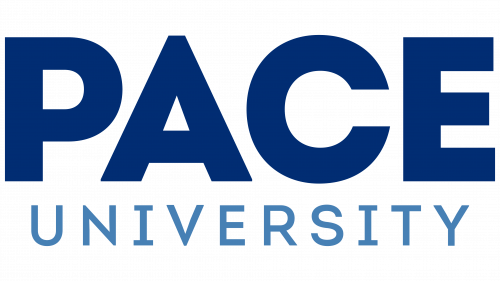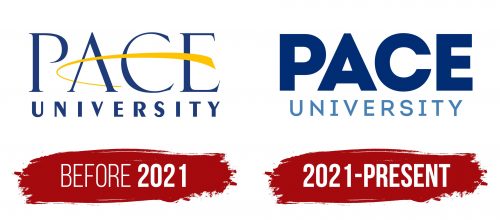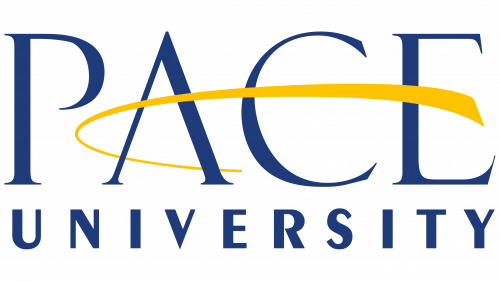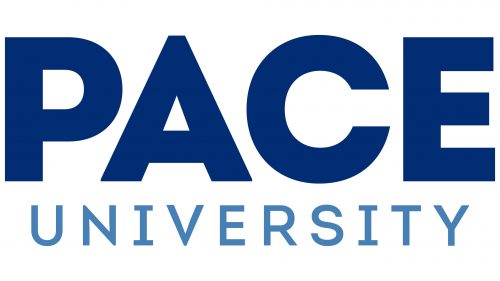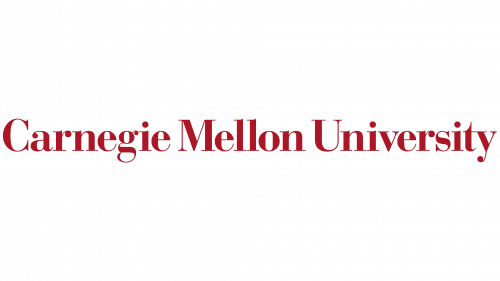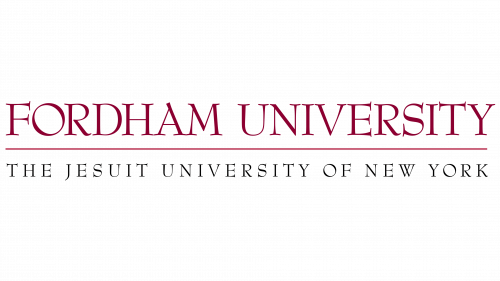The Pace University logo has only been changed twice, highlighting this private institution’s stability, commitment to tradition, and unwavering consistency. The modern brand identity retains all these key aspects while standing out for its beauty and deep symbolism. The logo is aesthetically appealing and carries important meanings that reflect the essence of the university. This is expressed in the elegance and clarity of each letter, which, upon close examination, appear aligned in a straight and confident row. The bold and wide letters convey a sense of solidity, much like the knowledge that students acquire at the university.
The brightness and expressiveness of each vowel and consonant emphasize the high status of this educational institution. The arrangement of the words in two rows creates accents that make both words equally noticeable and attractive to viewers, regardless of their size and style. As a result, the modern emblem is easily recognizable and strongly associated with the name Pace University—an organization with a unique development history. The university, founded in 1906 as an educational company, has borne its current name since 1973 and continues to strengthen its reputation in education.
Pace University: Brand overview
The history of Pace University began in 1906 when brothers Homer and Charles Pace founded an accounting and business school in Lower Manhattan, New York City. Originally located in a single room in the New York Tribune Building, the institution was known as Pace Institute. The Pace brothers were pioneers in accounting education, aiming to provide practical experience to those pursuing careers in the rapidly changing business world.
In its first year, Pace Institute enrolled only 13 students. However, the school grew quickly due to the quality of its instruction and the rising demand for accountants and business managers. By 1920, the institute had more than a thousand students.
Despite the challenges of the Great Depression during the 1930s, the institution continued to expand. In 1935, it was authorized to offer a bachelor’s degree in commerce, marking a significant step in its transformation from a vocational school to an accredited university.
Like many other institutions, the school struggled with declining enrollment during World War II. However, the post-war GI Bill brought many new students, including returning veterans.
1948, it became a college, and its name was Pace College. This change reflected its growing reputation and expanding academic offerings. In the 1950s, the college continued to grow, attracting more students and adding new programs.
A major milestone in its history occurred in the 1960s when the institution acquired land in Pleasantville, Westchester County, and opened a new campus in 1962. This expansion allowed the school to serve students from both New York City and the surrounding suburbs.
In 1969, the college became a university, reflecting the expansion of its academic programs and research efforts. That same year, the School of Law opened, further establishing its status as a comprehensive institution.
The university experienced significant growth during the 1970s and 1980s. New departments and majors were introduced, including the School of Education in 1977 and the School of Computer Science and Information Systems in 1979.
In the 1980s, the university greatly expanded its research capabilities, founding centers such as the Center for Environmental Legal Research and the Center for Applied Ethical Research at the School of Law.
The 1990s saw further expansion and renovation. In 1997, the institution opened a new state-of-the-art campus in White Plains, which houses the graduate programs and the School of Law.
In the early 2000s, the school made significant investments in its infrastructure. A new student center opened on the Pleasantville campus in 2002, followed by a new residence hall in New York City in 2005. These improvements enhanced the student experience and increased the university’s appeal to prospective students.
The institution celebrated its 100th anniversary in 2006. Over a century, it had grown from a small accounting school to a multi-campus university offering various academic degrees.
In the 2010s, the university continued expanding and innovating. In 2015, a major renovation project was launched at the Pleasantville campus, which included new classrooms, dining areas, and residence halls. The renovations were completed in 2016, greatly improving the experience for both students and faculty.
In 2017, the school introduced its new strategic plan, Momentum, to enhance the student experience, strengthen academic programs, and raise its national profile.
In 2018, the School of Performing Arts in New York City opened a new facility, providing theater, dance, and music students with a cutting-edge learning environment.
In 2019, the institution introduced new programs, such as a master’s degree in cybersecurity and an artificial intelligence program, reflecting its commitment to staying current with the rapidly evolving job market.
Like many other institutions, the university underwent a period of adaptation and innovation during 2020 and 2021. It successfully transitioned to a hybrid learning model that blended online and in-person instruction.
In 2022, the school continued to expand its academic programs and research initiatives. It strengthened partnerships with leading companies and organizations to provide students with internships and job opportunities and introduced new interdisciplinary programs to address global challenges.
By 2023, the institution had established itself as one of New York’s top private universities, known for its strong performing arts, business, technology, and healthcare programs. The school remains committed to providing students with real-world education and preparing them for successful careers, continuously evolving to meet the needs of its students and society.
From its beginnings as a small accounting school, the university has grown into a large, comprehensive institution. It has always focused on preparing students for professional success through practice-oriented education.
Meaning and History
What is Pace University?
This is one of the most prominent private universities in New York’s academic community, known for its “Opportunitas” philosophy. The university has multiple campuses and offers a wide range of programs, including business, computer science, and performing arts, with its main office located in the heart of Lower Manhattan. With a strong foundation in the liberal arts, it has established itself as a leader in professionally focused disciplines. The university takes pride in its diverse student body, attracting students worldwide due to its emphasis on career opportunities and urban life in New York City.
Before 2021
For a long time, the university used only a seal. Then, a logo was introduced, which, although fairly simple, remained unchanged for many years. It was far from ordinary and possessed a unique, almost magical beauty that set the university apart from other educational institutions. The logo combined brightness and restraint, creating a harmonious unity. Its vividness and originality left no one indifferent—it consistently attracted attention.
Although the logo contained only two words, this did not diminish its impressiveness. On the contrary, it was elegant and symmetrical. Just fourteen letters, but each one was thoughtful and refined. The word “Pace” was written in tall, superscript letters but not too dense, giving the inscription a sense of lightness. Meanwhile, the word “University” was typed in capital letters of a smaller size. It is worth noting that both words were placed in two separate rows, aligned so that they began and ended on the same vertical line. To achieve this harmony, the spacing between the letters in “University” was twice as large as in the upper word.
A key feature of the first logo was a yellow line, resembling an incomplete circle, which drew attention and was part of the letter “A.” This element looked stylish and unusual. The color scheme—blue letters, a yellow arrow-like line, and a white background—created harmony and emphasized the originality of the identity.
2021 – today
In 2021, the university’s logo was completely redesigned. The line, which was previously considered the main element, disappeared forever. The text elements remained but were rendered in different fonts, giving the logo a more restrained appearance. This change is connected to the university’s elevated status: it has four campuses and offers over 100 academic programs. Such significant achievements call for a more presentable, rather than bright, identity that reflects the seriousness and stature of the institution.
The color palette was partially retained, except for the yellow elements. The word “Pace” is bold and colored in a rich, dark blue shade. All letters are uppercase and uniform and lack embossed accents. “University” is done in a light blue tone with superscript letters, giving the logo an elegant look. In the new version, the previous parallel arrangement of the words is no longer present.
The Seal
The Pace University seal was also updated and acquired a stylish, original appearance. Its design features motifs from the past, complemented by timeless elements. Two outer circles, differing in width and color, emphasize the importance of the words and images. Along the contours, the name of the institution and its territorial affiliation are inscribed in large letters. A third inner contour helps focus attention on the central elements of the seal.
At the center is a graphic depiction of a graceful lady. She is wearing a robe, sitting on a rock, holding a scroll and a wreath—symbols of knowledge and eternity. The lady emits light, seemingly conveying the message: “Knowledge is power.” Nearby is an inkwell, symbolizing education and intellect. This image perfectly reflects the mission and activities of Pace University. Around the inner contour is the university’s motto and the year of its founding, written in words rather than numbers. The phrase “New York” appears twice, emphasizing the institution’s connection to the city.
